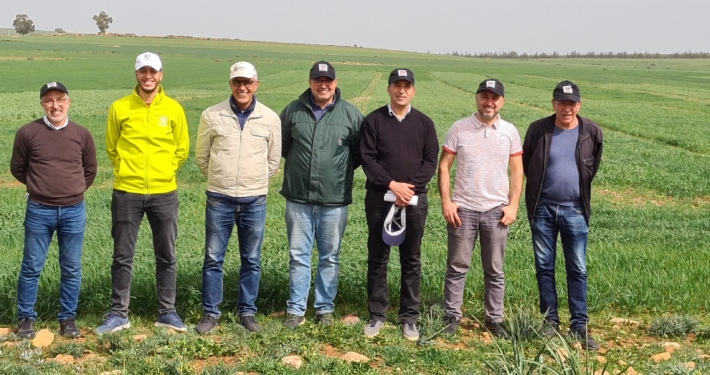
Experimental sites in Morocco
Visit to experimental sites in Oued Zem, Morocco
In February 2023 a group of researchers of the project team of ConServeTerra met in Morocco to visit the experimental sites in Morocco (Figure 1). A major part of the project relies on field experiments on experimental stations and local farms to gain insights on certain Conservation Agriculture (CA) practices on soil quality and crop productivity.
Effects of residues on crop production and soil characteristics
Livestock plays a key role and contributes to a significant share in food security and incomes in the region. Also, livestock is considered by smallholder farmers as a primary asset that can be easily converted into cash in dry years. It is characteristically interrelated with cropping systems through weedy fallows, residue, and stubble grazing and the use of woodlands and rangelands. These farmers face major constraints in terms of permanent land cover since stubble grazing is usually practiced by farmers. Indeed, stubble grazing by livestock, especially during the summer period is a traditional and common practice in the region. Trade-offs between the use of stubbles for livestock feeding or to cover the soil must be resolved, particularly in drylands where fodder potential is low. For better crop-livestock integration under CA, it is necessary to combine diversified crop rotation with controlled and improved managed grazing. This can be effective at preserving or even enhancing soil function and health.
In a fenced plot at El Baraka farm at Oulad Boughadi in Oued Zem, grazing management on cereal residues is studied (Figure 2). The aim of the experiment is to test different levels of stubble grazing effects on the productivity of crops and soil quality. The trial is established on marginal land in a two-year rotation (barley and a forage mixture of 70% peas + 30% barley). The grazing is managed only on the cereal crop at different levels. Those levels include 100% residues left after the baler as no grazing, 75% residues left after the baler, 50% residues left after the baler and farmers’ practices that may use a rake before grazing in case the national straw production is low.
The goal of this experiment is to optimize the stubble management strategies for crop-livestock integration under CA systems for increased productivity, water use efficiency and improved soil quality, to facilitate rapid and more successful adoption of CA practices.
Rotations of cereal and forage mixtures for the crop-livestock integration production system in semi-arid regions
Although pulses are important crops in terms of human nutrition and soil health, their cultivation has been declining because of various factors. One of the key constraints is weed. These crops are poor competitors with weeds particularly at earlier growth stages because of their slow growth and limited leaf area development. Therefore, a low input weed management strategy that works under CA is necessary to ensure the cultivation of those crops.
On El Baraka farm in Oued Zem trials have been established during the project with the aim of finding promising CA relevant weed management strategies in a rotation system that can be adopted by farmers in semi-arid regions (Figure 3).
The trial consists of three strategies that are evaluated:
1. continuous cereal cropping, 2. rotations of cereal with forage peas and 3. cereal with forage mixtures. The mixtures (barley + peas and triticale + peas) on the farm’s plot goes from 100% cereal to 100% legumes. Assessed was the impact on the soil and on productivity (yield).
On-station experiments were set up at Sidi EL Aldi, the experimental station of INRA (Institute National de la Recherche Agronomique) (Figure 4). There, four trials were established to identify relevant weed management options that can be adopted by farmers in semi-arid regions.
The trials were composed of 5 combinations of 2 cereals and 2 forage-legume species (Barley/Vetch; Triticale/Vetch; Barley/pea; and Triticale/pea). Within each combination, five sowing rates were used:
- Cereal full rate.
- Legume full rate.
- Cereal 70% of full rate + Legume 30% of full rate.
- Cereal 50% of full rate + Legume 50% of full rate.
- Cereal 30% of full rate + Legume 70% of full rate.
For more information, please contact Najib El Hantaoui n_elhantaoui@yahoo.fr
Figure 1. The ConServeTerra visiting team out on the field. From left to right: Oussama El Gharras (AGENDA), Mohamed Oulahraoui (Al Moutmir-OCP Group*), Rachid Dahan (AGENDA), Hicham Daoui (El Baraka Farmers’ association, Oued Zem), Omar Idrissi (INRA), Harun Cicek (FiBL) and Hassan Ouabou (AGENDA). Photo: Najib El Hantaoui, AGENDA
*Al Moutmir is the agricultural extension arm of OCP group in order to help farmers improve their production and livelihood.
Figure 2. Checking the fenced plot at El Baraka farm in Oued Zem, Khourigba region. Photo: Najib El Hantaoui, AGENDA
Figure 3. Checking the crop development on a trial with peas. El Baraka farm, Oued Zem, Morocco. Photo: Najib El Hantaoui, AGENDA
Figure 4. Rachid Dahan (AGENDA), Imane Amghar, PhD student, Harun Cicek (FiBL), EL Houcine Hirich (INRA), Omar Idrissi (INRA) checking the project trial on best management strategies of weeds on lentil and chickpea under CA. Photo: Dr. Mohamed Boughlala, INRA





